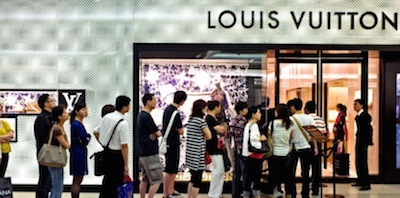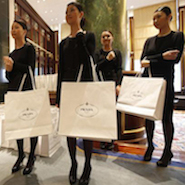Chinese residents will make 90 million outbound trips in 2020, with that number increasing by an additional 36 million over the following decade, according to a report by Euromonitor.
As reported in "How to Target Chinese Shoppers Abroad," outbound trips have increased on average by an impressive 13 percent since 2000, helping China overtake Japan as the second largest consumer market in 2011. With the significance and size of the Chinese tourist market only projected to swell, brands will need to develop a more nuanced understanding of the market in order to reach consumers.
"In the future, we think there is a growing trend that Chinese tourists from top-tier cities who have rich experiences with outbound travelling are more willing to explore emerging destinations such as South America," said Lulu Wang, research associate at Euromonitor International, Shanghai. "Meanwhile, tourists from relatively lower-tier cities might be the major fonder of current popular destinations, such as South Korea and Japan.
"It is suggested that international brands could make their efforts inside China such as advertisings on TV commercials, online videos and social media campaigns because many Chinese tourists plan their itineraries and shopping lists before departures," she said.
Where next?
On the most immediate level, stores will need to ensure that they have staff that are able to communicate in Mandarin and systems that will accept China UnionPay credit cards. Chinese New Year and its Golden Week, Single’s Day and the National Day Golden Week in October should also be on a brand’s radar, as they are all periods of increased travel.
China’s growth over the past decades, along with the increasing value of the yuan—even in spite of recent falls—and the ease of booking travel online have helped create a giant middle class eager to see the world with materialist leanings. The world has taken notice, adjusting visa and tourism policies to make it easier for Chinese consumers to enter, and China has since overtaken the United States in spending the most country on trips abroad, with shopping being the top priority for tourists.

Value retail China
Although Hong Kong and Macau are the most popular destinations, locals have protested mainlander’s benefitting from VAT discounts, and the government has taken notice of the prevalence of gambling in Macau, driving tourists to other parts of Asia and to the west. Thailand’s political instability and the threat of MERS in South Korea have also stunted growth, but brands should be monitoring these situations closely, as changes could result in shifts in the flow of outbound expenditure.
Luxury products are particularly high on the list of wants for Chinese consumers given the price differentials. This suggests that carefully tracking and anticipating currency fluctuations could help brands prepare for incoming tourists.

Cartier's Chinese ecommerce site
Political instability aside, this is particularly true in Thailand, where Chinese tourism accounts for 9 percent of the country’s GDP, with luxury items being particularly popular buys because lower taxes result in prices being 10 to 20 percent lower. The development of South and Southeast Asian countries has some brands entering these new markets, but in doing so they must be aware of the broader dynamics and travel habits.
Furthermore, the development of a Thailand-China railway, due for completion in 2020, will help the country remain a top destination.
However, the long-term promises a different picture. Younger millennials and Generation Z consumers are likely to shift away from the materialism of their parents and embrace experiences and other immaterial offerings. Euromonitor finds that brands with conspicuous logos and those that have flooded the country are particularly unappealing to these consumers.

Chinese tourists at a Louis Vuitton boutique
Paradoxically, then, the value-oriented older Chinese consumer and the “logo fatigued” younger ones may be better served by limiting presence in China. Higher prices in the country help drive perception of value on a purchase when traveling, and eschewing a local presence will help keep a brand exclusive and desirable.
Whether or not the appeal to exclusivity outweighs the potential for more customers is similar to an ongoing trend in retail, where mass discounting appeals to aspirationals but could hurt brands in the long run. Louis Vuitton, for its part, has found a way to do both, having an invitation-only floor and private residence within its Shanghai shop.
Despite the strong dollar, the U.S. will also continue to see a growing number of tourists. Brands that have not prioritized hiring Mandarin-speaking staff or soliciting support on Chinese holidays must follow suit, and the emphasis on exclusivity particularly among younger consumers should be accounted for, perhaps by withholding particular products from stores in China, as should outreach on popular Chinese apps and social networks.

Michael Kors WeChat
France has also emerged as a particularly popular spot for tourists, with the weakened euro suggesting impending growth. France is a known luxury haven, so brands operating there should make things easy for tourists.
By way of example, Printemps and Galleries Lafayette have Web sites in Chinese and Chinese-speaking personal shoppers; both also accept China UnionPay cards, as do Hermès, Cartier and many upscale hotels. Those that do not will inevitably lose business to competitors more willing to accommodate the needs of foreign customers.
Looking ahead
Euromonitor’s survey showed that twice as many consumers plan on increasing spend on travel in the coming years than decreasing, and the number of households with disposable income of at least $35,000, the threshold for international travel, will jump from 34 million to 121 million by 2030.
However, the tactics that may work to persuade Chinese consumers today may not be so effective tomorrow.
In a reversal of the more materialistic tendencies of their parents, almost 95 percent of Chinese Generation Z consumers say it is essential for brands to be sustainable and environmentally conscious, according to a report by RTG Consulting.
The continued growth of China over the next several years will ensure that its consumers remain prime targets for brands for the foreseeable future, as even a slowed China exceeds the growth rate of western nations. As a result, brands will need to make a connection to this group, the first born in a fully modern China, in the interest of long-term success (see story).
Another future change of note is China’s efforts to improve infrastructure to benefit tier two and tier three cities. Initially this will boost intra-Asia travel, but in the long-term it means that tourists could come from smaller cities in China where consumers have less exposure to English, making multilingual staff even more important.

Four Seasons Chinese app
Hoteliers should be aware that although lodging is currently a low priority, with middle-class shoppers preferring to spend their money on goods and large tour groups making up a notable share of international travel, this will not always be the case. As consumers become accustomed to international travel, they will feel more confident doing it in smaller groups, as couples or alone, thus opening up the market for high-end hotels.
In addition, it is not enough to simply understand the travel patterns of the demographic. Brands must learn what is expected of them besides lower costs.
“While the lower price of luxury goods is certainly a driver for Chinese consumption abroad, brands must understand and anticipate the motivations that lie underneath the surface of purchasing.
Albatross Global Solutions’ “Chinese Travelers and the Luxury Shopping Experience” survey aims to move away from what the industry already knows – the spending power and growing importance of Chinese consumers abroad – to focus on shoppers’ desires, behavior and expectations. While Chinese consumers make up one-third of global luxury purchases and purchase two-thirds of items outside of China, what truly drives the changing preferences of this demographic (see story)?
{"ct":"zZZ6VvgtPAJHKxSUkouJmNl2ybTli\/N9ZIuL80fbaajw7ghXx2ix0OicWRfQR9vby\/99BEc16DpN9ogvVVIm+nzEoVUAbj5SwVHInS4a0VpyxVffEppZzMMbsB6FLKuC26ZeVWQtsVSk7D3UzwHLuMfs\/XQVD+\/QoHyLexjLD+gYSHZE0HpSPPr2fVoBOGwK8psSQ2b9FcUEtrbZy8eXDpRippZI3yB0zFy8O7jard137Q0LsomJZ3zFIZMvzw2F\/6Fgv2pY4f7ynn9snuXz6uZ5\/RxRvAYYJHchNa0DCo3lym22oxW\/r6eBfX5qgtYz0stkabc6VBZgZhe9h2W0cwweecfPXL1krOfJQQf9hXyQbVFm2uPNZSKK5aphNpsiSZnL2lmGjEYW\/l7Z9Qgs62uzCvlODCm8\/LEwC9VpgzbGkzbEU\/LgbDy07quikxABW05Bd+ld4d\/6xMIsLPI7GMdRnqkBB5bmmkIcLttuuE8uXCWbVOpfeY3uDF9UhcUcNmqvtv2wskgJUv26dBE91TepJPCTI3kpJEw2I0fd57bw2kbQqgdfgXKh8fl7mNEQhKMGy9cu4\/V3IIAtO8Oe7HyzefqruhDR8Dk4XoBLev5lC6jKph5c6SdoQVqMEIPfQKrI1wumm4rDgKLlTw7mWxN\/LDDiFnn74a79vR4bzbioM3IdpXuHGYLhkjaQj28RQKE08E7eUslhe7EiKVEjmMq2vHDuqrEQVkzZVHiQWYTWDu\/q0Cs1MGS6pFvu5OKyQdvrT3L\/YlYabxHQWwoXhSVrYLE9Yo46P8hEKqiT9N1OJmhq\/FHBBm5+laUl7vtjCyrShsCMVQkWAthcEpi4j6\/xXUVT9nyY7iT3xJDIpFtP7n+bj+1BMV3Wm9jB9UOMpFE\/qCJrxKIQfurydwMPwsKm69AdLjTv4S84P79TX4f+MiKpjuVIkAlqHGSG839krdBm3jE6qnnWsU6s9h5cwHbpDRtuR6IIH8J9FktDk179I6Ab6m9W4l7J\/JxgZAkEeOfG+qnU+G2UfkApxj0OckBqKvRc\/5ZBQ7Cs3Alfad0uJMPMaF156tAN03\/W5EepqUIyMDaJa9U1kwkWP+jKF8no2PEv2LeXOqLBu\/LClPHfFdJAnksYlg0jw7P63BKjZtjnf8PU93H+zHT2dXgzVi4pRzxkmck54ET8TpaiepJqG4rMomKj8uK7A6O+6AQ6r98Y9upd3B4LkRA1vEvCwfl6PO7NVlUHRiecjLHEYBV6eaEZ744vyRKvVPSCnc6seCaV63ngdgvekqtrJmojA+BanUfB2QMCtaYqjyD\/EN30aLEs1ZqAx7tivtAaLPCAQk6BchKmos3r2Vi8ZzY+NdYHpa8MXG+JtY+h+tp8tRcF1TCrAwgp1DXufPA4+JaTLcN7jtZi6anfuSMdEn3r9aUutQihTudB2xUaIg8XQnzPE75sgte0SbN5VSxoWWj3NQ5fgNzt5N6u90UmFDggZcvaZBN7p3wVjp\/LzNRfB8zU9ZyRlcyS3w447IERMqFTuf1hc+1\/pRAHamK73ft7bycfI8NiDk3SVSOUWMKO4r7PAC0Zj\/CqGpicwXCwG7eLApC8KdQEvz+EYGCs8GCC2eWe9kcTDBy4rP6qB80KbdjyWP1gS\/f9qq06c9CK7tJwIW7tocb58QFVmvt68ZKHpZRnJxrC3XqnRPhZh3YPEbAjv\/X70yzGc+grEtHgkkwrst3v0h5+SPq2OccZ55iKeoIQF+IYllVfS\/rOXCghpQcERZ9Zji0vzeaPTFddGtWod+SYWS0+FfOdpQXB9Nar1HRNpCPyiJvZOmmbEVJ1HW6GSXA+HLxPv3Ptb16FCExZjOqI5miZlHx5VSxkcn3wJkvaMTt9RUOvvvZ8YTZ9AgXU8Qucf3Fi0XSu7DHRZCoQxC7WOVhQsIcpvxO35aAGC5pqYLHvIlbDuUouoeqtaLGa45HHE62Ru0TnREw0HnTlOZXz6RXaNkukzrnZfUUrTujkl3YFxZj0JrecHYs6lxyAvYKjZArua6Zc8wHgj6wSgMU00H0eSg3MhaHqQqKAcAsDUu4CSYCiWEcRcsk7swbqqwG6RVrHjA4OVksKKv\/Dc\/rPfg9j8TNMVm80l3XUDq1Atq3N7Ixdo8vziyqlZNmGHjc2HDALzE72S3PP8GOV2cTKkmIetKlKUB16Z2GHm8098BGTgaSG05LPK07NSB4KxsIm3P7ANlz7gBDUU9\/LXP4\/pOUGRvhugVQVvh7t9kzxUIXXbltO8MbB9s5i0uAeuwXI8wX9rtyHQzk2X\/4JhFMYtYKZbnzhVQOP3l4zNYaJiFTVxUuvSQ457mmQSwHYfRaV13g8a894VHMzH\/P4Oq\/W8NgFAr0xSreHIlDTMFu95GvwhHkaA4ZRWHpC\/oSRJht01HXni25glKJOlHH+azeMbQyEAbbezGAN4HcX7K31ck1ufzTW\/PgrSYM2MzhQGOVVmTt48q34A4OdY\/FTmGBRb4UNm0DUVejkMOr\/RtzY+2UcGSGpnIWJHRGOu3SqrC2j5V7sUrmsIfzWCHuSqsFNV0y5zv8AXjMjZ+dcbemveHuy1W8MXsJ9iO9l9FPHlco+Dvhz8hB5u0nTT+IfHEizNMP36\/Wsju0Q6uzCSzPXzg4diFKgEBDwXx4B7hzFGS89\/DVrFw2uYTE5ne2I7NJzXK\/4ZXbcERPu1sAZGC2EX2GAS3Ibq+DhWJ2O0qNc6d\/jKj7d4tGeUn6tgDIV4o2oPHHnpLBsUOpHkr5tDqjJgbnmfE9yBin53edPQca0q7JCw26sSZOgUJgD\/NmK3JarmMsZUM34nyMFUfRhJ5FT5DGZgN0Z\/c3vPkRJ9yDqNTH6jctaBqE\/Mj4GUoIbZ7tC8sJuZuBmLLe7fXotdZLkD5nO8xF2toBsm1sc4glOYFUSlGRDpmZip79Syqt9D0Mkap6I818QqXayDD+zLiFak+r3Nvo\/cALjPzamuagozRYBm0DYkG4yDi0QA4\/3a8PhiYbsp81Wt1jNLKAaByxk63nsHb56PEzTTqDDZOmfSNILYv7QTaz+5uiJM94v0uK8abwzbq+J5sskGvhTnZyLkxVJUEoptpkijjjorH9gN6TGmWu28BusNqurER0YRysa7JKmZOHGhg+qvHl+xQGFwSRfMVYF2dTVcYFUOxnsPH+0U4S3hb\/YfiVK3ui5YyRd1vArl20BbGJF6Wn3XXQM6wkIMKgYArrgEaPhR5yFbJ4kg9fPAGHqjcEdprGGOEmlVuN51WjHxYdtTIjuR785HzMnTxBd01coS9XxwIGndZ9T5gllRoLxAXTNuzUjfXhHNfRW\/hsOuyGVxgEEdTb7cGELht25lTUawZNWS3\/9\/\/bfpgDxImVDmDtCJBXhgP\/tapcNDx\/j2fXMUn5Q87SuD0zKp9q6Mip7hfRf5AGF+FLz3XOHQmevvh5I732fES\/dCOX+6\/RKBSN\/TjWlL5QkZKwxBzjBgiFeDwrzxQ2OJZNStoUIi81udkNdpKjntf3NQ04OF00t2vQEfqesKKZU985Ii\/tU5Qvg\/4WgxUy\/QQBFNyTW0Lr8iyiPRVXBPTfjUuMmtytmvucEIwzcvdTDyXzWRvx0Smwyx97vWwSyDBeiJBvGx5Yl0E1GIDq18OibybgIcpIw8gbaR3H0hamHrUrERiChW9DBnJ15gNCqHkezJUTUDgz9eFZr+REGjBVKXha5FN+4GfjRlQFL\/sD5fnen9Z8Ihfnuce5pV52y+18+KZtlylMXlRCZOWeaKkZ3UBHGd+e9LjbYfgu\/QLlH0cUAFobAwyS+HYlp3zFOCzgKss2UOJAycW5Gew2US\/o89xLwx9TtNPGlV\/02PDJgpw0XAWDNam2g5yqDgIBHZ6D3MEG6TLXo086TBV9prFeUAB9vJAY1XA0LlWLu0NsSWu62CPX+hbour6Mq8XlnyYX7s4caBLvMj9d2+bdcDaK6VZZCkNxm5PWnyO1Gi0IiAlv9+vh\/QYMtNEsIvh4ycCs6ztvXBSH1enawYXvnSQaANLSVgesColSIWaK8PsD4SV9xYjfwsFtZB19CGJmuN9wOONkkFGAFhlUh2a+degTv+nT7mL1lC\/9uD4lktAfhZ4ijTn7OrGkx0lLgsu7hbkQl2RlPqAHartTUDFvYievPQIhlBF+g57OIW3CtRD9sFrV2o3q0E03akWiCernAdJHccn6HxxCHhGAREW+luB9nkU+XlaqQmauZMHlI3o1XgwWJ3M7qMDrbcmyqQbmP6V7VB5wnisIrXQPhSYCJMrZZkOACgeDGMfvf0kyJJe51oBummpzaU9MgB+wdsfDb01PjgtUyewW+dVrRYMwgD0R869jEwmlgiPwG069WRYeQTCW5qg4meJtU6peBCFdWB4Dn9tg8BRTuKRLMKuFvblaVquQHy\/hTDzWF6wqxC0Dp4x\/ON77JCtf3HuYoDdOJTGKiAspo6ZiUI28s\/QiwFtVZidNX9nFVPrgRpPJvMODXjfdshwBXKzFoUbt3cwsvpRgFBFIQ1N+MSkJrYMAaUQRepk9E+HBf9xI6O3kZKsLt9otxKuF2BdAHolELLhc+a9BoQrotk25ci3z7w1KLkrkrdxW4nL3pjrGdvDlyGqwUSS2m7Z0mnPu1SPmxC1BJEbjJkmRGvWTcOdJ53MiUXjEcawIRCFL61xsAzQ0G4AO7cL3grQr6Z3AGxd6ZBrcWEwlEYSI515rsBeavbjXZyUB0ulxcAiIv9IfHGCNhfoHYR7Uh0lZR3Mb7r7W046jty81KVJFjdU39dR2l6Id4pUbS6vjBSrq\/UelQnbgJceiLQcDRWoPsCcFE3pJ3Cg767yXW6tNsUN9vyGJ3B1ML3cSMX3E1Eshq1DwjvWJz\/+k+zO3c8vMmv4QZT7iqIdXSHGwoXCZR+73sWAVb28dZkPUOq3SB60zk8SN71hdxFLDdVwu9mn\/t9QeHkZEvl4yE6cconRTey5TS1grn8liDMdpD5GJVJQhHHVECqZY0gSbc58YOoBzsFdn9NjeLXMehTlb3R65hCKlYkapQhnAkvYeEimi3D2S65II4ERhlr1f3VeHmIlfHzWfKuqx8sIxIrYU5Rp2BCBcmS9uUCq\/3nsiohk5NR73AdWoMZRClUGi\/knw2H1CdvF\/uEWd93EeQxUGbj77o7J+lqbMtSiN3sJmv2ropW0ABEP3i9Fyexd0sySvkuZq6oTg08+FW6ZOC1f1xa5Vf2xo9vJk0ARHYTKjns2r8RKflYLZb1nzktSBXuP5cTyv0Hri500lcJrJcnOOID7nB6AYeAZBz9qOyel3zfUM8gmw97WtlsIq0xpRz77bbU1BKzBSRH9vox1ansXL4yGRh9kZ81zt6NINtVoJt63fG1EcKVxAS78r+moVaQkLojaFSfVW\/y0WQMrHouXjmndrd1fpytw2rFvixQGLesF5vwrdWK\/Aqj+mitDHv8iUdie3nHnE\/1Fbl+x2ErdJxcUHw1gwi8LcfdcQVkITj7p75LzpFlr1Eb4xvGiCjrVGmGb0a1TV4JZuHMRdOjrNglXpWTEpvqVYK2eSrPRBrxb9ErpH+8U6mosgdDUmN6q7hbxboPHFQ+1GDeulesUNPiVvl40Y8cvsJCrAzvpjg8IVtZyzoYkO2Rg6FwzPZhpcYIdbL+8Xt+AfhgljaM62q4QYL1L9gep8TZ+ChBguNS\/sFoyfPwbgzNeDcfopKjzagZdZqhbYsmihp\/5sfbVptAy\/fhC\/oi7VQyfGd5s15MLrSntccA+CUfMNWly0o2sahdVANEDDXYa47dv7UhLQe56cKwyitv88wFSk3C6tJQVnFjZj8m9bXv0+wyGHSTvJYY8daroU88iigYXnXt9eYrd5+GeVVhpe4IH72CFrnJ7duAGo+oiEbRWEGJEnvtKJ4RGgTxOuYmbscm4y7T9k3aru14L2H3iF8wqS8c4no1cFMj+aYnjgMVnHoGGcgR7UG+oEYoVcUB6EjW61B3NZ\/k04E2yXGF8gLx+RyUfByBhrUnhyCFeoSdMalqan4oUXHYrrfQvPJIbkzccIPdRjpAdh1C8sYqJpNmagbnOg+3t0sxcGiWyXk7qUqa2PYj14M4yYvj2\/KBJlACqLtWXFBX4dVUx\/sCODo+b9OIxffy07NhqUbWlzuKO7L+w5C2KNVFLIeihtXfWpcaXzFa2C5Fog5veDaFbIx1hydwEo\/R2K8u+yeGUE+OF91AQ0c5d1gH6PbpOJKycJvnLSxaLV\/CITC4663Jm0sN6Bqaofw2RnHmr2C4cl7IyliMMJJH0iCPMJGGeFhLIxHIWm0fkpmgv0gzPIsGk1TSnw8h1q0IQU\/MuAnrDXJgneMzD3JzP3kK2pQiBgxqmN7Lk+M3Hahd5boG0K3niXtCXGdc13uuUxJncScZuvFm5x0zZ3KuAp6YUz7REgS7\/WVtcOI\/aEcQNNae+QmXEt9iXVoVCgV0POzE9nlaGZBCS8Mz4fhHTRJsQerCCU3cqOL9xZGK0bHM6A\/6AqHuyzZ8sj7flinXAT4ec52ezNwrP8UxwLJb0weU0HpQyH1bomo5pZpX2CjTwbfEdGPzxCHG5uDFgeQZMxTZ9fTorNmKt2J3q7FxsbyMiREKu1mphuXCNTYu0PCwRszKdYIaiZYQNIyBfyPiri6oQIP5iCW6d\/zH8442Ook\/NPH95uS+LzxjTSzRCHCcjUiP+hY8FGLze5X29TsCb9d0CSKN\/S0GwuTBMWty3CkdQLyj5\/cniEMEdI0POzCI\/XVrwXwQVFD6VeyFqXHNItt2fINwFzYG7EU+J069HKgJ4uI6xi\/nhT61ygy+Jggw+v0TIe7rsUnmvgRj+Ee89Tjpt4HRgcJ5URJkg2U45KZ7rrkLoR98RPnecwXIHDX+Ibjf5qyXHMqqrSSFZ6P\/P+gr7iyHsDL\/3+gu2O0BnJyVprsWf+FJLVJooUpOX1I\/c+reIGSVW\/x02Qgnl+8kr50E+bd9eAcoIha1\/87PA4MTPcwM8FJdaBBsT0ze0T6YEkaAadUZOE5ODs3p38m03faIhNwrUBzNzUHpfzZet\/VigSyZ4fcInI7sdlgsMKeZQBzkg7V8z6kQxi5Sp\/EPGAbOvdZ8Xoz8pX\/eFy+ozLvh1F4rM7xCsTxjfu0wkfQUDooyxTj9O1xgt039yEJ2GOWhphkAtLlr\/O5QQIKCNNiXjhQ8tl78FtIw\/U\/1cyNqeWFyO+0QqlEE+w693ogBojlcNDXZbsqLK97qqTsl1B57QxuQlx+JPd1KSoQAVquQMMa6OmkYaXs6P1rrVN92uOmu0gqWDDPm+p8+0Tl+9jRQ0Xt3PhNHmsh6hJSS+2SAPEYzHdlgobyx3wWw+c26YF33u3It2HhkE6yWhcZMvzGYaGn4cXv1pflXCzbc8Z0UYY88PbKEpYlmaO2zugzwFUPkjLf1mmfAA7xuwNnztyR74HGsjoxqz2wzcUMOBWeDfEbA7RXZYy0a18eE\/YsRpAZ27LUZvThqMqVe+B+fWHdTfdSUynfbvct45mLeid9EeGXqzF56AHXMYs5zQcGdKI5NZ0C1j8ir5hrhriH7AnuUaj4CPOjbqRA9zPXHZ+S1UtCd03zuuIncgE1w4H5\/aHpIvl904x1yuzErqUDcWKNlXl34uzXICkRQv\/kVfKph4Wg2HWt2APyt+9yL1KCLin2N+78EGar8Itj+junac1v1CmlVXNadPTiXKb09oVfmNTAeEGriYRaGBbdpn6OrolhZctp1H2oVaWYTIQDZ6pS4\/yadhzQ8GQnaQDEN4a91vkZnAri5zZSw4tLdMPG3kzIDhMcWmOXpR5wN1ho7U\/CcSelJWrzaKKCCNLNgLXTHkENDIJzQGkf7XaKWLKbhWLLT06tjhwOv5VIjKlMlFHChGOhdiHeRtIrDRHnLecoOFeDYrBvH5PN+q3H6Aruuq8dUgY7Ihpnr\/fH52JuTNbm5J4KOiqr3EAtltPYoJZKrvYwYSRQzcllEJzr5wFDqkq22ZWTg42a4z60pbLqgpGm15rMJssdx9kwvDCA4HHdtRuRg3nTVg72x5EDJVkqDF75PPVtinqeO+yEobYbD8ZHQqV+tWRMRhmg+OfuHhI+e+apmgHFMHNAWqr81wYr96DDUYpEPLAW62w\/nlbR7JHH8o7CS6xkieMYpbj5GHlLwm9dYit9AhkSDg6pSrFf9nrxzEiKX\/QijnhJLuj\/9as\/bSJgbY\/KLE+fW9fL\/tjVcR9PmgVsG0LVL9qls57IjWFKaoMLlaisIZO10QSMKQV3yKNyEa02ceBmYHPEi3Hh7sGkJFCNt6sO\/hJR1mGsUKZZt0dwqaWWnyLm\/+iiyWGnTQH9iXclsgIuNd5svJV0EWov0cPpRU8mUiS9808bYy5+Q2J06949XmPhnUQcskV62qNvum0pyjqyjAiKlXwfYUnIRZXesjKC\/IeDRCNIJEB6850XyGvALPZI6n9DNPYI+XO\/kG53\/Ch8XkhHvSgXlVQEDictd89TzdpXp5fPz34AV2ge1+NHbKEqMSlqbFkTt1mfAWlPRc99r\/EHKrXAgbvQ5Z7gd98JZGLo8nhPo9RuDX6\/1jhPa\/mzF54qhbIZzQ2rPdmMu3HvymT8ZARDyphz6ri8NfTQVmazwxhz\/JelA\/pAYD5AGtgOMitENyKJd5G\/hbGdQOER\/MDaE5KhsOeCdONLUbtgQz4YNd1KvFeAR6+yyC7fLcHXbmtyvLm+S2oluduA0IYZtUhzD6x2spuAKgsqioPulRPQ2xLP\/WYOpaQO+uaC\/Aip50PRCV9qX3CRUC2oBvTdP9G\/v66o5la2M8+9LFszC0\/OTK8tR8Gp1OaUjwngNzfAlJr45gA4Cw2toIs06GlVTdCtGBcBDj\/TIgmoynnWXD6\/6r0se9I13hymPkxNkk499nUlz9O0aiiIpokYLG69X3k1yLpjLqrOpVxJNqjlds9sy0uyvyoJJJNRJsrFbTPj\/dwciiQwS4VjcPX8LenJ\/t+HV5vp\/t7Aq8zYOFvWjjPdMDL1\/rMPoTr3z6tnJkZijjB2zr7JwbZz89trKzSAi6uGUlj073nDloJkbW1oXcmHNF5Zg88UewJ0S6kOp4D3bmvdzQN0Geo+HB8YP7lDykqvitTFqUM4umwHkclSRLJrDOsXfj0TrnQUFjZhQwRaVM31wtK4P9pO9a5EE6TuyjIjhWSCRLfQv4dqlHVkDKAPIcdY1vSkpBA0I+yuJ97kNkcmgVMzTwGtgAIw2ZJ\/SPvWT2HM8JqJkjjhk5M3ruF2Ew\/UPb\/V0CEj9Oiaibfan1odluhXdjCjf0Tz4F3I8hUsLKNRTt8fWW2D9sB3My1ZrhZ1nHhkNzTz3DOPUT5WFHS4gyCXOSj2O5ZNr2mvnUZPTa8Yb5W\/L47oteUAcVamTl5RUQHhzZYW5qN+QDq+zFXa1pXQz2QIE9Q8J+nmif6wHuoPc0FAWhZn+GYTRkCX51U5ZukRYa3j\/uFOJEJEPBhuiehc5TOtC+Y\/EgsR7lURRHJ2TpEUKR43ZxLTKVNb36610SaUyeMqQJP6CtLYiqEhYlrfC4F5yFyS8GX\/G7Fji7m6jvYuE3osgkSFITCZpjgNJB\/qK9nPhm\/\/4N3x9jlplCGS8Qt9zus9hSZyX9a0deWmK58plGRDCfkn+Nw+hVGNzmRtjpvRs4\/4OVYnFzmWvR7px3Sz\/et1LLwaTu\/TPCAADwiCcAWyYz6quhHlrJwO7uhAkvhkq+flmWl2jr4eRI6s3DPmSlburktqjBK66WnQl+Zi7JBS9ZzupikyjSsCefM0dJDte6baA2z3BiZ5zGdlB4\/tIKOSs4n+V8pKx\/Xid1PayBPByVOBvXtnti8Ml4yXdhIXeT3z7qIjl9RrYPMEl3I+6ue0sjpbW6r\/C8q+RvkVy9egMpfmShVgLSlKmwjxC\/e7rQMB3W+WwP73mHj0GamLzk8\/Xz8DI6B5KtbPHhzapYL7LCYwqqv0qKjpW04IVpG76baBnnMRExm81KNU521k2txSKk87l9wfc61r5uS0v5GfMz3FibPIWAty9z6b+HLupM\/J97mVKvkQacUrecjzFQDO3v1eiFQdW7Ef9AmOFRp6I9GaoNW8ODIn9j6KNYkVKcCo79HDUR+nrKD3MEWAUtsYZAy3VR2\/Jt4\/0kLTWPui0HWW0aZcBZnui2prI0a4g1QFQSil8M6W+y6wtjKnNmp8jrZBOxkYxk3cEAnFKTQH+IthuvsISE1D1zv1XV9kYeS\/Z8M3\/iIF7yFSev118Sgoamo0mWUnZxq\/naB+1cNapp9otThBc6GUFLxUtc\/6REH5TV5gT\/bgt41vMyMBAHb89Y2PQaSrZt5UpoOtMD0pxiFXFO+JcEb+KuzmxCEDTw+thAIaDt\/WvAHDDWyTOr4INxAcx+sU+hoGw\/idHsngXQE762MZbjtbfK6CpTIrbwznj+aplLeV7S6Bjynj61EVjK5K1V67oaQ0AdyGa9Plnf8PUw5lVuPAHJ7U0X05atZ3iAtGNHxg40fAl4GxsN9RNTggvYRPZlGjD9Ozx13x+2ZjB1Oy7GgyHZUHNQYupMp\/Pgy0t+MYhVWv2jVqHVD0\/G8t1FMOaZtJQPYwJ8nDPaZiT6XgGi1HIry5u35vF8x2Ml1x0GQBTuZRSHnkg9CO3cVFFyMlztI9ySBpaa0\/3wFAtxShvvKkdReECqfIK9lH\/1vOp5tEzjD91+4hSrw0nGK0xJKiTnHRqIkUevIypKutx1Vgh0iG9uazjjN3DOak28dDmxJWkK1mB+GCvQxfJtnbx6SGGwHZvPl5hOrhHhKF7zViP3KzJEDk+Nnv4GrChrYIA1UFsGCUub8\/hEcpGw\/lx5tI+wMUmW5YHrpfhXzz0JcvtUUL9AuesH1tuSeavr9kFVEq7Ug2FoMTQ98ia0jKh\/KvA4xDGv4v+OgD03NCjy\/b+LDM4jr56MDHAKCGUSqXvejrFG3\/mT3+fcF2GWqLFdnFRuzIxmUPOtxrAdl2fEp78b8TPLZxQTQAOkqViP48kdw7gm\/HM+va9jRUufrhXMotPzRCvunvYEt7SyIy3xP7nqjz8t4AEb24IW2VosKeRfpPjqz+lT1Ns8vTztvZEtlHgX55GPpO+UiQY7XYjaHUH8xzaNCAUmamqk7kZ4\/aDdXVd2uRUmq2DPjcWiggCkiNbHEU\/nVXQUd4VtNAxXafwES9Ms34\/I3o5w56ihnXdo0B\/tRkMY0HeXZ93uW\/C9OW1iLP00X7SCfV7DEi5zUIRTBDRdhTjPnqC4kXbeRKs3TspQNrHboOZuJ35nq76BvECVW16Dj8O38N\/rpdZTmwO7SjdYRHD5\/bArXydP7Tekhkbou1f8IrPDT49k03DsI4oyfaE6Uj2TFQ6euh0KzrsWcrO5VhYtTBaTicDaQZi55y\/Jx0KZEaIGOPK\/Hjs0aWK3LNtm8WclOjh3o+xGz8m\/a+Tn5JlrNiShzXWVrby4ysShXAHVshG0qi9A\/BRitF1ObToiZ6CHTddwTRZPZTy9R8yqT3+6OyhDxVn2GjHGKB0s3CKNEZFrA\/KTC+4ZCmFI25cIwSkY8+CYJI78ir4YrxUA+N7OeRyK5\/1FjKrCuYSzQmZEBttKm0P\/h3+wk4taB0XMo2Cb4\/ivknrAr34vsJqvOMPnqahhOcj4SSCOR8E+uTf6VqzIHeGKrow0GbRyBspFCI+TfPW02rHwwA2ziGWhgDPJn9iz9ejJLm8LOA3aS8duUNiNIupwYzdEcgYdVd0vtz\/EgTLX6K4wIExi2kirZoYJo7HnqLc3+dC8jULtLieQcIZyy6nAfgKVvqw+1dggvAnVdMttUzDuqJmHiK5GJ\/ByX+nixLRiH7KEWDQ9zCDx2Nr\/YRElY4xNTiVLD\/DK96Q+39A0evKc1exlPK2is34\/1aJLdl06F5uy6XzpaLRHB+iRj1IqbV9a4YomWCKRD6i5mwk2egvk\/hoCLaG8KsXLWjXJp0BVU5Gdrdi0lFk+ydKJS5VEfVudeCV0IMcKrrvbm9CAJd4+AXDsGJqct9Co8iHMGNxqMK+hfwUgxjaK6Pi7GyYjN1Ead1NZ+qlGBUPe4edLtuEgJoM4kGHeSbOFpQP1pG3s7j1G7djbjrwh7xoO13dh68GinvrbYb4Hi8Gn\/H1Rq2dGLL9lHQpGxcRpPDV3fz8Qq103mXQbdBLBzFq3YS6NqGq76MhWzG8liG03ESWZyuWrLUIXXLhVtQaEBHmTtFtrAg08tNY4SfBrmCIkLcV4bZaZsGjonFoqGBDMxht2Q3OWXgpQ2suDTQCk6MnrHspQXSM+KULScgkKh3kjGMkEspiPbMaJtO0Y1wHzt2xoMMy7WlHgZNtYDdKVUdzKrQ7YcqC6DoKBFoGpwzi+MmYbgV72SSQmbG392AGpOzbMlDrk1YBjUWyKKC\/JCVE187EDxEQGpISp9zFW+\/VzFNeNIVYrUZX2kJ6dme4\/DB9K9CmcHOa9qS9ZVkSzdTbQ3Lr0FDuJrDp4euoCoxulXJs1B4by6CM3SuHlbjIhMtPSWPmlywVs8VDrYBzLdv+lOCiiMH+wA4xwNLUVCrRtsBNkqRVpoY8DL07xgeZ5cyE0ecnzVf5PvLcliIIX0Xdea2zdrVYzFwHN4qbafViHXUyrAK1X1As+S0hf+WGr46GUNGTWL6P39tdv39GyQ073XEdht8CzYq1j5BeRfkktjKnVjnDxB+ebjmQgvcmqT6wJwvP+TWXrXNAHL02yIcQQ48Gj3Cz4Rv19g3g\/IjesRgTIVAKNBB2mnzFuzy7CkQbgy1A7LpfgGLEqTyTaKMsH5IO9UGgbI6sah9T3HNITl2ox0OHTtvi2vdjTBlujr1qrv5GAvhW1p+4r8NCN8Wqn8e4fDs9udN4VgaAvcVLoNvQni3DO0hDWH5UzouMy1u+wSBuaztQdHo2wV+nUeGyeaJuiz8GMh0Qer6pI6goM2YiA\/XdRI4elWsjE9P5UJTSseYTLDrwfVnVvBZPKuzepThCqstcdsxIDBAxrIQmeNWGbCUxvc4G+8dFKuoxmvc\/adZ8OeVK\/q0NdaNLwc80dxGswtePz91coJW\/dcdiWKumFF5IEcL7aDJ6u5Scjf9RH+MRl01sYEchpANV9G\/1VOZmpIsltIQlXTZRZGqe\/y0iedtmPsQBQFULvnx4XQnSV3Y8YX6aqGiymZh1LVeCOJiSdXtZFcB1kcPWbCoU37UrdvA+cUNC\/jBCtH6AU0hGHTlRPtW\/bB6ZvEGNeoPkHkWLkHf3nc2MFSWRY7k15uYl55fp75v2xU8awG8ev7mgwGYc3Dk4DqAJvTY42xbYoXoxaP4slhDYLnafAFm91fvTFdOrBbdmEOcz2zvDZd1gfUe4nd9Z1SYorWn+PJN6ZZzbGB\/UJIg7Q34wmxUDfKz2NKpUE9ziNKYvqNrRNHWEzQSIvX7s9ZBGcnnq2P0YGD9qFCaUlkLAYEu9XdzAYN\/OtAgbUEfVrK+uzdupOTIVX3pCMMmVm7RyyaKdBbkr3BAcXiyq+TaTFxGozTCMx7fYwSYXHdWNxuAPAWs2lcUqheRs+d+hAVWlGvsjYjqhHXamKVNleEgZEHZGUJRcHilcn3ITmEke0eYvd\/KUUK8+1vX8XN82yaZrKc8MKjdz5s23vfWb89f6uSAvp6dXVNPnN6uA3+r39yEheEcKL7jtLVAlKo7sDAYBuO+QIZmxCaW2+GdgS5ePFLjYJmWipi7ZUGB4zaBo+vw\/v5ww5HDCp5mup9jfmm0BMC6azhG9pMV4iqM+emdKkf0ZGL1irWV1Q+Ppb4aDS1gejN1VbQarJPMvoU0Lwx4vEcDv4toRJcN1FMuWMyl2whbMnxLWL0t1mWVh+fnGcd+Qbg2Z48vFUh4E78ozTtt13uPmdcD9B2lyn0ofEAP+bWWO0awqf6andfLTK8gV3ST4b6Lv+autmRJhWMfEwxRhbClw8lhFwXG5Jl1aIZj4tgXYX4kbb+bLOkvsQeBwmqcb8HwzFnE5zNbwW10uvHzJZDHqye0SRkth1jKalSqrDdsIMPTG1hcfWHQ19gTp+OxucmRHZnel\/8w0pLvMR\/YbAqWKyq1AWk0x8nIgCMi5fiJrGemtS1uCxBocemMlADQDl2H8cJSeEeivfVSJ6qc+EGOPBGcP59TkQ1L9yc+Svl2Oi0DYXUaPeHGRw7sSXqE+7jMD9hpMxblhMVpZOcWrEmZXq0mKhBaF94hHWmq95tobqYE1W0TQL+RfftrRhMduR\/y8xSjGa9W4jKRpuFV96GoE+XtE1HUYMAr2rZRZgZi6k5x87LZ\/eqc3gU1luUIVutcBtcv8hFqp6MW4zNFfM5EC9TRz7PEhU3WmuQf+ihkUxozdaG0RxWw7Y5ahYLWo+FUjXlM5Y4Vp9jG17ifdVBJDsUkfMIeoXS\/KJhl2K+CE0pJmeheUMyVF+hfve4+rHF\/DshRXJpvIUG3+0noVb5iDiaV4kcVbEn2sWrtgyZ2srnjeP6KLqS9xfUdyEuA4ufobluA1X3hNjPC8B5BOPUXNF9z6zmfuW6OHNAwlXTnxYIzF+IgoglNFBkeeDWRL+ujuXz0AaCTdRdsRRT9NMiu6cAu9nOwbYTH1aHo8LUA+U8RANsfyFjnkaeJ5uthF\/c95EtNr4HevXV9PX3H\/VtPdG322RYhwk9+MGteEXHSt24PCHqqRlPWfhvQfNQZoamjp9pYDzQjzMeStfL4NMy9K0QFNwkuXC1oqyQLSC6AHPJVkTCKdqtYS96bCuAzV8QtUbZDSW4uYqK1miW6rPfWX5XpqC9iesoSp5nITMva7Bug+9jvVGm9ZXwT\/LS3mYBctlO\/SqfnioLTh9PzsVz5rzDnADC68v3Z33SuveFuuQ33Y4CVr81QOJU=","iv":"ec66ff728c06fcd4298109054aa86a87","s":"39909b68b3100102"}
